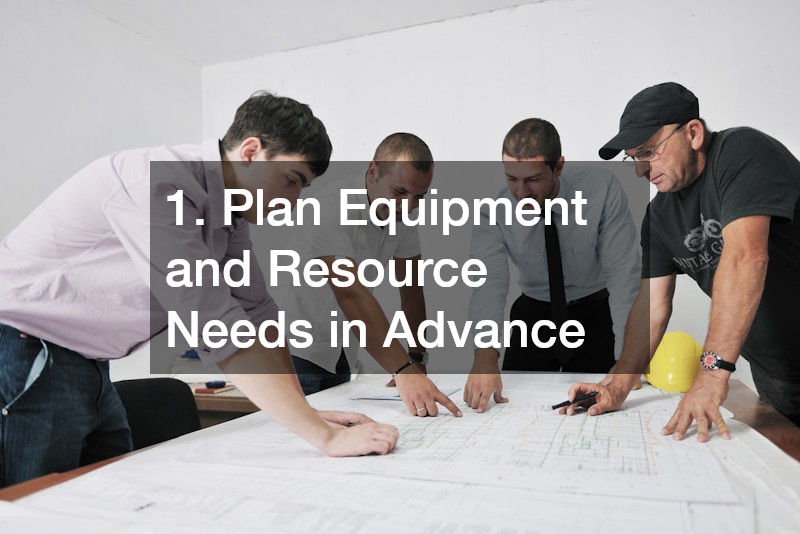Efficiency on industrial and commercial sites isn’t just about working faster, it’s about working smarter. A well-organised site can save time, reduce costs, improve safety and ensure projects are delivered on schedule. Whether you are managing a construction project, a manufacturing site or any large-scale operation, implementing the right strategies can make a measurable difference.
Here are five key ways to improve efficiency on your site while maximising resources and maintaining safety standards.
1. Plan Equipment and Resource Needs in Advance

One of the most effective ways to boost site efficiency is by planning your equipment and resource requirements before the project begins. Knowing exactly what machinery, tools and materials are needed reduces downtime and avoids costly last-minute orders.
For instance, arranging crane hire in advance ensures that heavy lifting tasks can be scheduled without delays. A crane that arrives late or is unavailable can halt work on critical components of a build. Similarly, sourcing steel supplies ahead of time guarantees that structural elements are on hand when needed, preventing interruptions caused by missing materials.
A detailed plan should include timelines, delivery schedules and contingencies. This kind of foresight streamlines operations and keeps teams focused on their tasks.
2. Optimise On-Site Layout and Storage

How a site is organised directly impacts efficiency. Poor layout and disorganised storage areas increase movement, cause bottlenecks and create unnecessary hazards.
Arrange material storage close to where items will be used, while still maintaining safe access for machinery and personnel. Storing steel supplies strategically can save time retrieving heavy items and reduce the risk of accidents. Similarly, planning the placement of temporary amenities, including toilet hires, ensures workers don’t have to walk long distances for breaks.
Clear signage and designated zones for equipment and materials also help workers find what they need quickly. A structured layout reduces wasted steps, keeps pathways clear and supports smoother workflow throughout the day.
3. Implement Effective Communication Systems

Communication breakdowns are a major cause of inefficiency on commercial and industrial sites. When instructions, updates or safety alerts are delayed, mistakes can happen and work can stall.
Invest in reliable communication tools such as two-way radios, mobile apps or digital project management software. These systems allow supervisors to relay instructions instantly and keep all teams aligned.
Additionally, holding short daily briefings helps everyone understand priorities for the day and any changes in plans. Regular updates can prevent misallocation of resources, such as scheduling a crane hire for the wrong time or leaving toilet hires in inconvenient locations.
4. Maintain Equipment and Facilities Regularly
Breakdowns are one of the biggest threats to efficiency. Machinery that isn’t maintained properly can fail unexpectedly, creating downtime that impacts the entire project.
Schedule regular inspections and maintenance for all heavy equipment, including cranes, forklifts and loaders. Proper upkeep ensures equipment operates at peak performance and reduces the risk of accidents.
Temporary site facilities such as toilet hires should also be checked frequently. Ensuring these are clean, stocked and functional prevents disruptions and keeps the workforce productive. Similarly, checking storage areas for steel supplies prevents damage, rust or other issues that could affect project timelines.
5. Train Staff and Promote Best Practices
Even the most well-equipped site can struggle if staff aren’t trained or aware of best practices. A knowledgeable workforce is more efficient, safer and able to respond to challenges quickly.
Provide induction training for new staff and regular refresher sessions for existing teams. Cover procedures for handling steel supplies, operating cranes safely and using site facilities responsibly. Encourage a culture where workers follow procedures and report potential problems before they escalate.
Training also helps teams understand the importance of time management, site organisation and proper maintenance. When staff know what to expect and how to work efficiently, projects are completed faster and more safely.
Promoting efficiency on industrial and commercial sites requires a combination of planning, organisation, communication, maintenance and training. From scheduling crane hire to strategically placing toilet hires and ensuring steel supplies are readily available, these measures reduce downtime, improve safety and increase productivity. By adopting these strategies, managers can create a streamlined, professional work environment where tasks are completed on time and resources are used effectively. Efficient sites not only save money but also improve team morale and project outcomes, making efficiency a critical priority for any industrial or commercial operation.
